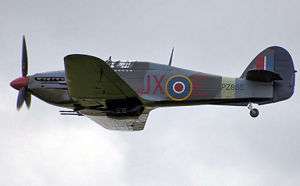Karel Kuttelwascher

Karel Miloslav Kuttelwascher DFC and Bar, "Kut" (23 September 1916 – 17 August 1959) was a Czech fighter pilot, a flying ace of the UK's Royal Air Force in World War II. He belonged to the most successful RAF pilots of Czech nationality.
Pilot
Karel Kuttelwascher was born in the village Svatý Kříž (now part of Havlíčkův Brod). His paternal ancestors were ethnic Germans from Deutschbrod (Německý Brod); the family name means tripe washer. He joined the Czechoslovak Air Force in 1934, became a fighter pilot and served with the 32nd squadron in Hradec Králové. After Czechoslovakia fell under German occupation (15 March 1939), he managed to escape to Poland - like many other Czech airmen. Then, he departed for France in July, with a majority of Czech airmen.
In France
In France, the Czech airmen, including Kuttelwascher, were initially enlisted in the Foreign Legion. After World War II broke out and France declared war on Germany on 3 September 1939, the French started to use Czech pilots properly. On 17 May 1940, Kuttelwascher was assigned to the French GC III/3 fighter squadron, flying a MS.406, then a D.520 fighter. It is unclear whether he achieved any victories in France or how many. Incomplete French documents do not confirm any victories, but Kuttelwascher claimed he destroyed or damaged several enemy aircraft. His most likely score is two team victories and one probable individual victory. When France fell, GC III/6 squadron was withdrawn to Algiers. Kuttelwascher left the French service there on 1 July and got to Britain by sea.
In Britain
In Britain, Kuttelwascher was assigned to No. 1 Squadron RAF on 3 October 1940 with a rank of Sergeant. Therefore, he is officially recorded as a participant in the Battle of Britain. In December the squadron was moved to RAF Northolt and flew combat missions over northern France. On 8 April 1941, Kut made his first confirmed kill - a Messerschmitt Bf 109 fighter. In next two months he added two more. In 1942 he got married in England and was promoted to Flight Lieutenant.
On 12 February 1942, No.1 Squadron took part in a bold attack on German destroyers in the English Channel (the Channel Dash). Then the squadron was assigned to a new type of operation - 'night intruder' missions over France. These were night missions by single aircraft with the intent of shooting down German bombers over their own airfields. Due to lack of radar in the aircraft, these missions were undertaken only during a full moon; they were dangerous, demanding both navigation skill and excellent vision. Kuttelwascher flew a Hawker Hurricane Mk IIc coded "JX-E", equipped with two 200-litre under-wing auxiliary tanks,[1] which allowed for 3.5 hours of flying-time. He quickly distinguished himself as the best night intruder. He shot down his first aircraft on 1 April 1942 (a Ju 88). On the night of 4/5 May he shot down three Heinkel He 111 bombers in one flight. In three months of No 1 Sqn's night intruder actions, Kuttelwascher shot down 15 aircraft and damaged five, from a squadron total of 21 claimed shot down in 180 missions (including 67 trains and railway stock, 5 boats and one road vehicle.) On 28/29 June 1942 a Do 217E-4 Werk # 5370 of 7./KG 2 was downed by Kuttelwascher at Trevieres, near Caen, with all the crew killed.[2]
On 8 July 1942, Kuttelwascher was assigned to No. 23 Squadron RAF flying the de Havilland Mosquito on night intruder missions. Partnered with P/O G.E. Palmer, he flew six intruder missions over France and the Netherlands during August and September, but did not encounter any enemy aircraft.
In October 1942 he was withdrawn from combat flying and assigned to staff work in the Czechoslovak Air Inspectorate in London. In June 1943 he was sent on a six-month mission to the United States On his return he was assigned to No. 32 Maintenance Unit, where he served until the end of the war.
Karel Kuttelwascher claimed 18 confirmed air victories during the war, which was the highest tally of any Czech pilot (followed by Sgt. Josef František), although his kill count may have been higher - a number of 20 is often quoted (with two aircraft shot down in 1940). Karel Kuttelwascher was also the RAF's best night intruder and 6th best night fighter (others flew mostly radar-equipped aircraft). He was awarded the Czechoslovak War Cross 1939 five times, as well as the Distinguished Flying Cross with Bar, and the Croix de Guerre.
After the war
After the war, Kuttelwascher returned to Czechoslovakia in August 1945, but quickly emigrated again when the communists came to power. He settled in Britain and became an airline pilot for British European Airways. Kuttelwascher became a naturalised British citizen in January 1956 when he was described as a salesman.[3] He died on 17 August 1959, while on holiday in Cornwall, of a heart attack.
References
Notes
- ↑ Mason 1965, p. 11.
- ↑ http://www.aircrewremembered.com/KrackerDatabase/?q=kuttelwascher
- ↑ The London Gazette: no. 40731. p. 1522. 13 March 1956.
Bibliography
- Brown, Alan. Airmen In Exile, The Allied Air Forces in WWII. Stroud, UK: Sutton Publishing, 2000. ISBN 0-7509-2012-2.
- Darlington, Roger. Night Hawk: the Biography of Flight Lieutenant Karel Kuttelwascher, DFC and Bar, the RAF's Greatest Night Intruder Ace. London: William Kimber, 1985. ISBN 0-7183-0574-4.
- Liskutin, M.A. Challenge In The Air: A Spitfire Pilot Remembers. London: William Kimber, 1988. ISBN 0-7183-0691-0
- Mason, Francis K. The Hawker Hurricane IIC. Leatherhead, Surrey, UK: Profile Publications Ltd., 1965.
External links
- Czech Night Hawk
- Czech Spitfire Club - Karel Kuttelwascher – brief biography, list of victories, part of Pilot's Flying Log Book, comics Czech Night Hawk (published 1943 in USA), pilot's gear (flying helmet, oxygen mask, Irvin jacket, flying boots), memorial plaque.
.svg.png)
